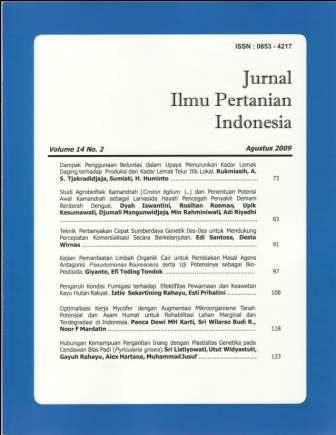Optimalisasi kerja mycofer dengan augmentasi mikroorganisme tanah potensial dan asam humat untuk rehabilitasi lahan marginal dan terdegradasi di Indonesia
Abstract
Marginal and degraded lands in Indonesia are considerably extensive and include many kinds of soil, for instance acid soil and post mining soil. Efforts to overcome the problem of acid soils and post mining soil are the use of biological fertilizer such as arbuscular mycorrhizal fungi (FMA), phosphate dissoving microorganism (MPP), and nitrogen fixer microorganism (MPN). The objective of this research was seeking new formulation of biological fertilizer which constitute a consortium between Mycofer with MPP, MPN, and humic acid which could increase its ability for supplying nutrients and help to increase plant survival in less favorable environment. The first year research comprised the following research stages: (i), Preparation of augmentation materials, namely multipilication of potential microbe (FMA, MPP and MPN) and humic acid ; (ii) Formulation of biological fertilizer which constitute the consortium of Mycofer with MPP, MPN and humic acid. There were 6 formulas of biological fertlizer which were tested in this research, namely (a) Mycofer with addition of MPP isolates 1, 2 dan 3; (b) Mycofer with addition of Azospirilum isolates 1, 2 and 3; (c) Mycofer with addition of Rhizobium isolates 1, 2 and 3; (d) Mycofer with addition of humic acid; (e) Mycofer with addition of MPP, Azospirilum and Rhizobium; (f) Mycofer with addition of MPP, Azospirilum, Rhizobium and humic acid; (iii) Test of Mycofer plus formulation in post mining acid soil and latosol soil at laboratory scale with corn crop and Legum Cover Crop (LCC) which comprised (a) Centrosema pubesens (b) Pueraria phaseoloides, and grasses which comprised (a) Panicum maximum , and (b) Setaria splendida in pots with 5 kg capacity for 3 months. In the second year research, the first factor was microbe treatment, which compriserd 4 levels, namely P1 (control), P2 (mycofer), P3 (mycofer with Azospirillum/Rhizobium) and P4 (mycoferd, Azopirillum/Rhizobium, and MPP); whereas the second factor was technological treatment which comprised 3 kinds of technolgy, namely T1 (SOP of gold mining), T2 (technology of soil amelioriation), and T3 (hydroseeding technology). Result of the first year research indicate that the five crops species tested gave different responds weather in latosol soil or in post mining soil. In general, all plant species tested indicate that they not only need single microorganism but need consortium of microorganism. The plants were better growth when inoculated with consortium of microorganism combined with humic acid both in latosol soil and post gold mining soil respectively. The second year research was conducted in post gold mining land of PT Aneka Tambang, in Pongkor, Bogor. The results showed the tolerant crops that did not require technology and addition of microbe for their growth are Calopogonium muconoides and Setaria spendida whereas Brahiaria humidicola and Centrosema pubesescens only required treatment P3, P4 and P2. Pueraria phaseoloides and Panicum maximum were categorized as sensitive plants because they required additio of microbes and technology, namely treatments T3P3 an treatment T3P4.Downloads
References
Anas, I., Widyastuti, R., Hifnalisa. 2002. Bakteri penambat nitrogen dan mikroba pelarut fosfat dari gambut Kalimantan Tengah. Agrista 6
Karti, P.D.M.H. 1999. Pengaruh inokulasi cendawan mikoriza arbuskula pada rumput pakan terhadap pertumbuhan, produksi dan serapan P. Di dalam prosiding Seminar Nasional Mikoriza I. Bogor.
____________. 2003. Pengaruh penggunaan bakteri penambat nitrogen, cendawan mikoriza arsbuskula dan penambahan bahan organik pada Stylosanthes guyanensis. Prosiding Seminar Teknologi Produksi dan Pemanfaatan Inokulan Endo-Ektomikoriza untuk Pertanian, Perkebunan dan Kehutanan. Bandung.
___________. 2003. Respon morfofisiologi rumput toleran dan peka aluminium terhadap penambahan mikroorganisme dan pembenah tanah. Disertasi. Bogor: Program Pascasarjana. Institut Pertanian Bogor.
___________. 2005. Pengaruh Penggunaan Bakteri Penambat Nitrogen, Cendawan Mikoriza Arbuskula dan Penambahan Bahan Organik pada Stylosanthes guyanensis. Media Peternakan.25.
Setiadi, Y. 1993. Respon pertumbuhan anakan Paraserianthes falcataria,Trichospermamum burretii dan Acacia mangium terhadap inokulasi mikoriza arbuskula pada lahan pasca tambang nikel. Laporan Penelitian.
_________ dan R. Prematury. 1995. Respon pertumbuhan tanaman albizia, sengon butho dan acacia terhadap inokulasi inokulum mycofer pada tanah podzolik merah kuning. [Laporan Penelitian].
Tisdale SL, Nelson WL dan Beaton JD. 1990. Soil Fertility and Fertilizers. 4th Edition. New York: Macmillan Publishing Company.
This journal is published under the terms of the Creative Commons Attribution-NonCommercial 4.0 International License. Authors who publish with this journal agree to the following terms: Authors retain copyright and grant the journal right of first publication with the work simultaneously licensed under a Creative Commons Attribution-NonCommercial 4.0 International License. Attribution — You must give appropriate credit, provide a link to the license, and indicate if changes were made. You may do so in any reasonable manner, but not in any way that suggests the licensor endorses you or your use. NonCommercial — You may not use the material for commercial purposes.



















